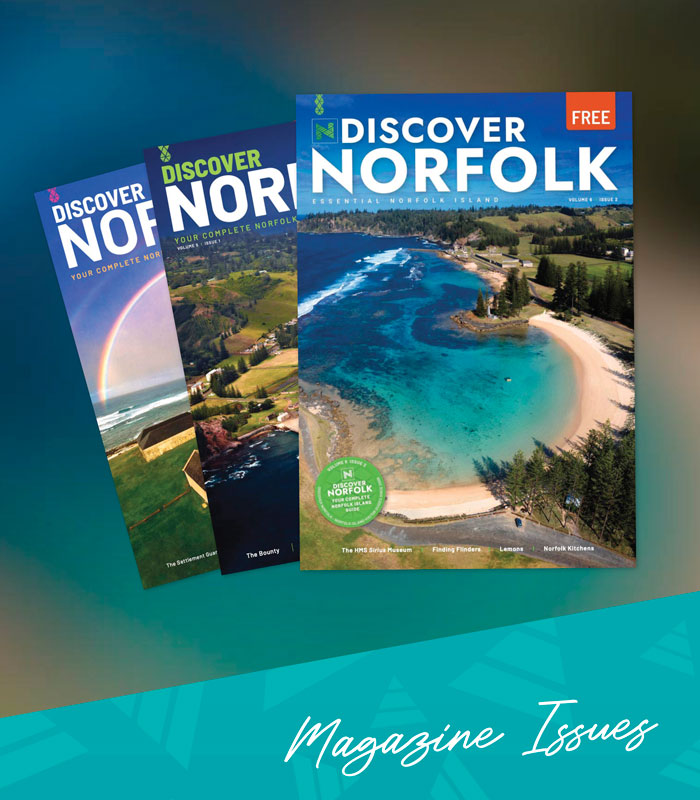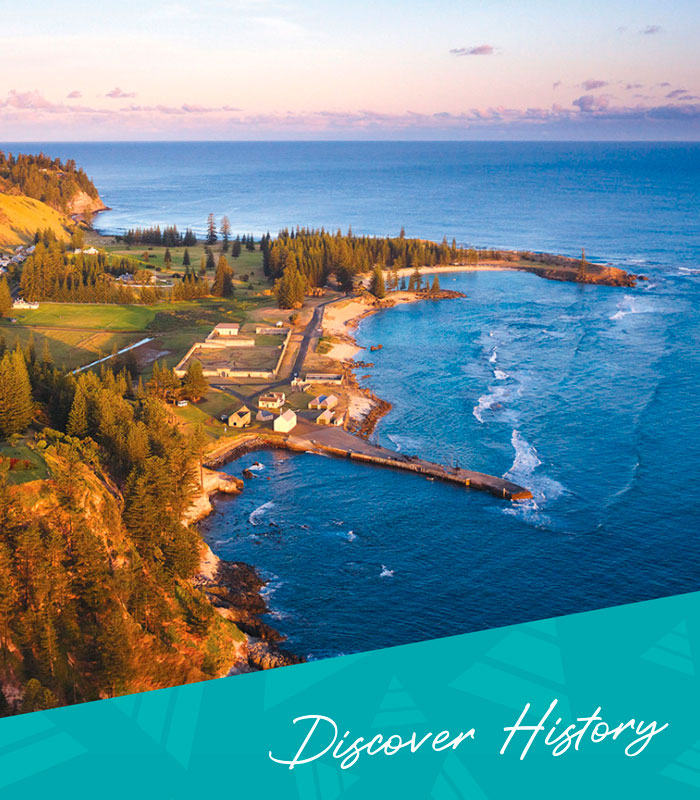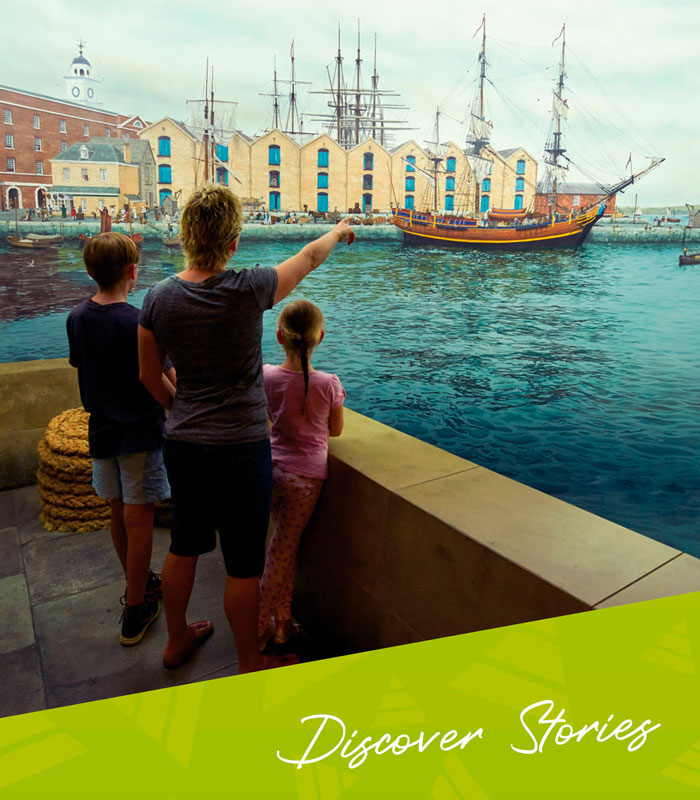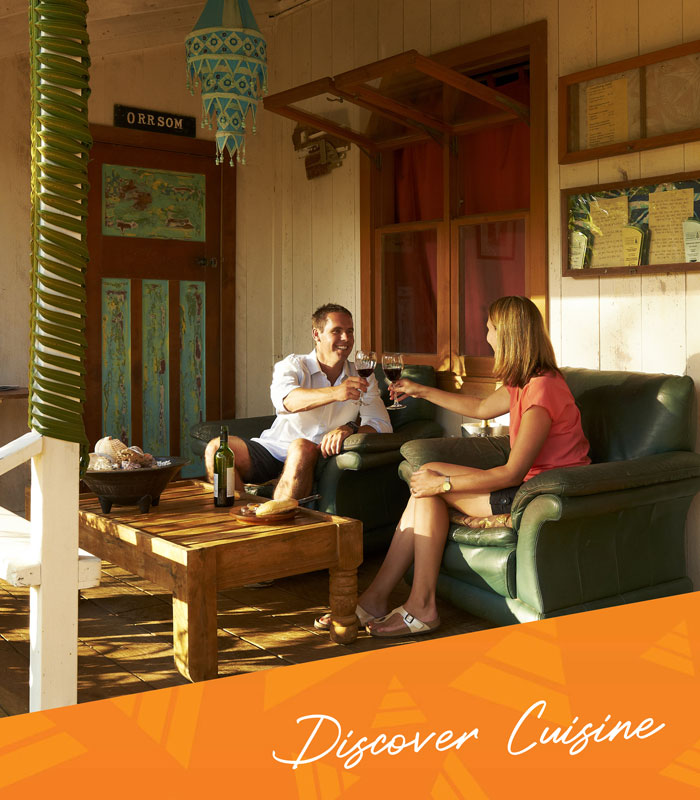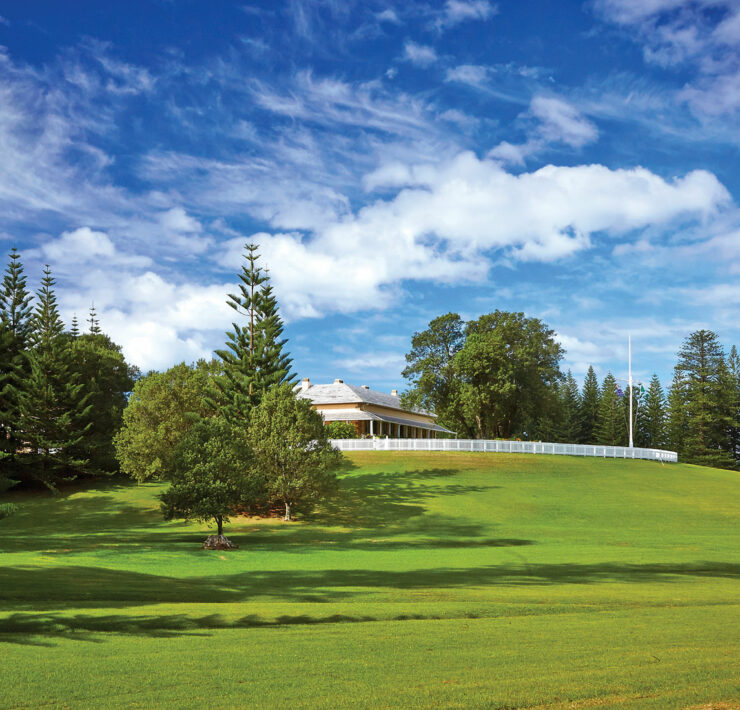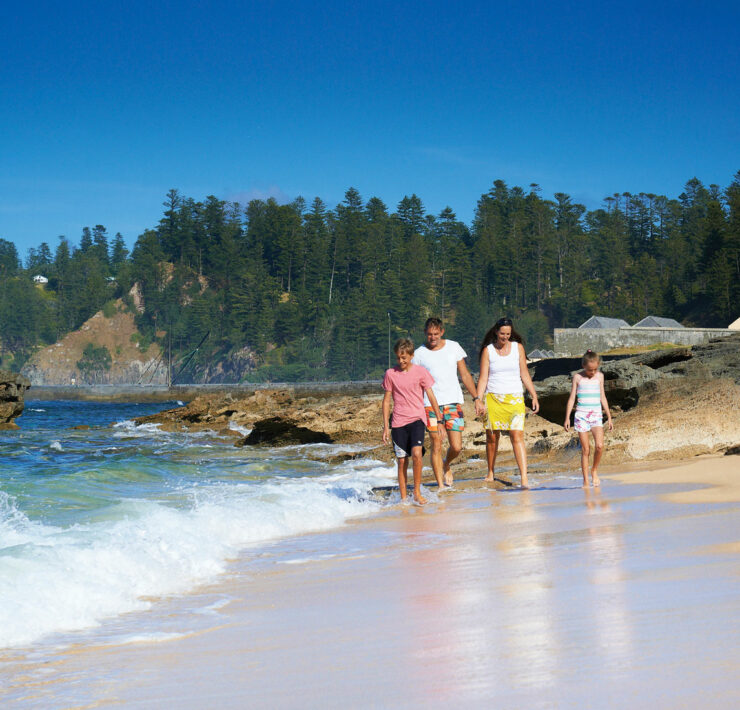
To tell the story of the Norfolk Island language is to recount a moving tale of birth, growth, hardship and maturity. Unique sounding with a pleasant lilt, the Norfolk language reveals the evolution of a new culture: a direct reflection of the Islander’s mixed Tahitian and English heritage. Born of a necessity for communication between two distinctly different races, the language termed simply ‘Norf’k’ has become an essential element of a Norfolk Islander’s identity. From these innocent beginnings however, the language has been disparaged and scorned, and its native speakers ridiculed. Fortunately, great steps have been taken in the past few decades to preserve this endangered patois, and the resurgence of Norf’k is a testament to the resilience of the Norfolk Island salan (people).
The conception of Norf’k occurred before the Bounty Mutiny in 1789, with the Bounty crew and their Tahitian companions finding ways to communicate during the five months of breadfruit collection. As discipline deteriorated over the months and resentments grew, Bligh’s crew would use Tahitian words and phrases to speak derisively of their Captain. In 1790 the burning of HMAV Bounty on wrongly chartered Pitcairn Island sealed the fate of the mixed race, creating an ideal environment for the development of a new language. Isolated from the rest of the world, and needing the skills of each member to survive, the ‘Pitkern’ language developed from a peculiar mixture of cultures. The greatest influences on their speech were the English of the surviving mutineers, the Tahitian of the women, and the West Indian Creole of Edward Young.
The Tahitians were familiar with the environment and things relating to women, and their influence in the new language can be seen in words such as habuu (pregnant), rahulu (banana bark) and naenwi (species of grey fish). Some vocabulary, pronunciation and idioms can be attributed to Cornishman Matthew Quintal, Scotsman William McCoy and Cockney John Adams, though Edward Young’s role as storyteller to the small community resulted in a heavy influence on the Pitkern-Norf’k language. Words common in West Indian Creole such as nehsi (nasty), morga (thin) and morla(tomorrow) are used frequently in the everyday language of both Pitcairn and Norfolk Islands.
Norf’k is considered by many linguists to be Atlantic Creole, despite the Island’s location in the Pacific Ocean. A Creole is a stable natural language developed from the mixing of parent languages. Creoles differ from pidgins in that they have been nativized by children as their primary language, meaning that Creole has features of natural languages that are normally missing from pidgins. The children born into the Pitcairn community spoke both Tahitian and Pitkern as their native tongues, and “tolerable” English as described by the first visitor to the Pitcairn community in 1808, Mathew Folger, Master of the American whaling ship Topaz. Later visitors to the Island reported that the inhabitants spoke English “perfectly well”. Most probably this was a conscious improvement by the Pitcairn community as they sought greater identity with their English heritage after contact with outsiders.
John Adams, patriarch of the Island and the last remaining mutineer, had himself taken tuition from Edward Young and learned to read from the Bounty Bible and the Book of Common Prayer. Once a heavy drinker, he turned to God and used the religious literature to teach the emerging Pitcairn population to be honourable and moral. This religious transformation and dedication to the Bible text would have caused a considerable shift in the Pitkern language spoken at the time. The arrival of Englishmen John Buffett and John Evans in 1823 and George Hunn Nobbs in 1828 into the Pitcairn community brought further religious and educational instruction, which increased the Pitcairner’s use of English and elevated the standing of those able to speak English well.
When the entire Pitcairn population arrived on Norfolk Island in 1856, the language began to evolve in response to their new surroundings and lifestyle, and today is classified as a separate language to Pitkern. Words such as kepsais (capsize) and faasboet (when a whaleboat fastens to a whale) are examples of new words added to the Norf’k vernacular which have stood the test of time. In true Norfolk fashion, the words were used figuratively to add humour to everyday situations. One might say ‘Hi miek mais haat kepsais’ (He makes my heart flip over) or use ‘faasboet’ to attract attention to something funny or to a ‘whale-sized’ exaggeration. Two lovers might also be stuck together ‘semes wan faasboet’.
Today, Norf’k is approximately 80% English, and 20% Tahitian, St Kitt’s Creole and other influences. Modern English words predominate the language, however they are pronounced with lengthened vowel sounds: a common feature of Polynesian speech. Old English can be seen in words such as aklan (us), which is an abbreviation of ‘our clan’, and wetls(food), which came from the 18th century English word ‘victuals’.
Important social and economic changes on Norfolk Island, and the Island’s easy accessibility from Australia and New Zealand, resulted in the erosion of Broad Norf’k, which is the most un-English and purest level of Norf’k showing the least effects of interaction with English. The most recent census on Norfolk Island in 2011 shows that only 22% of the Island’s adult population speak Norf’k, which means that Norf’k speakers are overwhelmingly a minority in their home. The presence of so many Mainlanders, including marriage partners, has meant that Norfolk Islanders are more inclined to use English as it is considered impolite to speak Norf’k in the presence of non Norf’k speakers.
In theie attitude to language, Norfolk Islanders in the past were unequivocally proud of their ability to speak English and their connection to the queen of England. Until recently the official anthem sung every morning at Norfolk’s school was ‘God Save the Queen’ and many Islanders considered themselves to be subjects of the British crown, not of the Australian government. It is probable that Norfolk Islander’s doubts about the worthiness of their language was closely connected to the dubious early history of Pitcairn, and this made them an easy target for the suppression of their language in the early 1900’s. Although Norf’k serves as a source of affection and camaraderie among Norfolk Islanders, as a kind of private acknowledgement of their unique background, there has always been some degree of active discouragement of Norf’kspeech. Norfolk parents often doubted the wisdom of their children speaking Norf’k because they believed it might interfere with their progress at school and their ability to communicate properly with the wider world.
The most tangible evidence of pressure against the use of Norf’k has been the policy and action of some Education authorities at the local school. Each generation of ex-school pupils from 1900 to 1980 is able to describe instances of verbal or physical chastisement for use of Norf’k in the classroom or playground, and many Islanders recall the humiliation that they were made to feel for using their native language. With the appointment of an Australian headmaster in 1906, a concerted effort was made to eradicate the use of Norf’k at school. In 1915 a new school rule banned anything but the ‘King’s English’ to be spoken during school hours, thus speaking Norf’k became known as ‘Kilen aa King’ (as in ‘Murdering the King’s English’). If caught, children were often caned or made to write out lines to the effect of “I must not talk gibberish at school”. The first headmaster to introduce the rule predicted, “I feel confident that it is only a matter of a few generations when the Island ‘jargon’ will disappear altogether”. Luckily for the Norfolk Islanders this prediction was wrong, as after WWII the policy was not enforced as rigorously and in 1987 the policy was reversed, resulting in the Norfolk language being included in the school curriculum.
A revival of the Norf’k language was heralded by two significant publications: A Dictionary of Norfolk Words and Usages(1986) by Beryl Nobbs and Speak Norfolk Today (1988) by Alice Buffett and Don Laycock. In 1999 Alice Buffett also published Speak Norfolk Today and Encyclopaedia of the Norfolk Language. Two linguists have worked extensively on the Norf’k language – the late Dr. Shirley Harrison who lived on Norfolk as a child, and Professor Peter Mühlhäusler, Professor of Linguistics at the University of Adelaide. A Norfolk woman now in her 30’s recalls the day Peter, a complete stranger, entered her secondary classroom speaking Broad Norf’k, leaving the entire classroom dumbfounded. His ability to speak Norf’k is a tribute to the hard work and dedication of those involved in the establishment of Norf’k as an accredited and phonetic written language. It is also encouragement for anybody wishing to learn Norf’k, irrespective of native tongue.
In 2004 the Norf’k language was recognised by the Nofolk Island Government as the official language of Norfolk Island with the passing of the Norfolk Island Language (Norf’k) Act 2004. The Act recognises Norf’k, and the right of Norfolk Islanders to speak and write it freely without interference or prejudice. At the local school of around 300 pupils, Norf’kbecame a NSW Board of Studies endorsed elective from 2001, and is now taught to all students from Kindergarten to Year 9. Community teachers are employed to assist the development and implementation of the Norf’k study, teaching an array of subjects from grammar and pronunciation to music and poetry. A Norf’k Language Camp is run annually for Year 9 students, where speaking Norf’kis encouraged as they learn an array of Norfolk skills such as fishing, cooking, weaving, and Jaero (a traditional Norfolk card-game). Alongside the re-introduction of Tahitian dance, and even renaming of tourist attractions into the Norf’klanguage, it seems a great shift has occurred. Norfolk Islanders now have a conscious desire to identify themselves with the Tahitian side of their heritage, and are very proud to speak their unique language.
In 2007 UNESCO (United Nations Educational, Scientific and Cultural Organization) recognised Norf’k as an endangered language. This was the acknowledgement many needed to realise the value of Norf’k, and its role as the living manifestation of the Norfolk and Pitcairn Island cultures. UNESCO believes that as languages become extinct not only words disappear, but also ways of seeing and describing reality – causing the loss of valuable knowledge and worlds of thought. By proclaiming the year 2009 as the Year of Norfolk Language, the Norfolk Island people took a great step in recognising the value of their native tongue and encouraging its use for posterity. Norf’k is a living language with subtlety, precision, wit and power. However, it is the innate strength, humour and affection in the Norfolk language that has carried its salan through great adversity, and allowed them to stand where they do today: with the Norf’k language as the backbone of their identity.
____
Image Credit: Robin Nisbet
www.robinnisbet.com
____
Article content disclaimer: Article first published in YourWorld, Volume 02 Issue 02, 2012. Please note that details of specific travel, accommodation and touring options may be outdated. References to people, places and businesses, including operating days and times may be have changed. References to Government structure and Government businesses/entities may no longer be applicable. Please check directly with businesses and/or Government websites directly rather than relying on any information contained in this article before you make travel arrangements.



